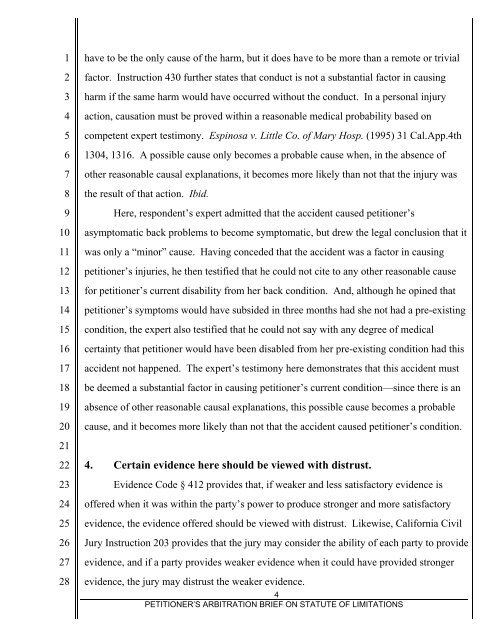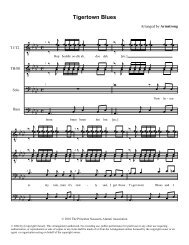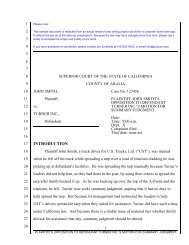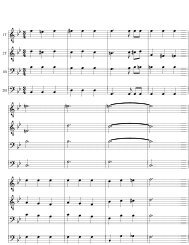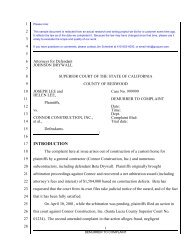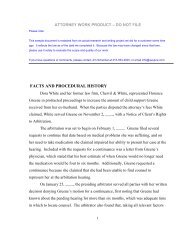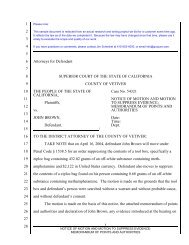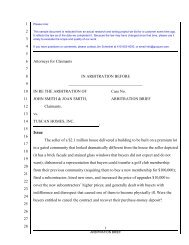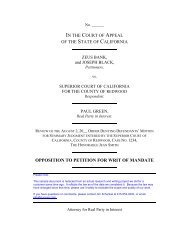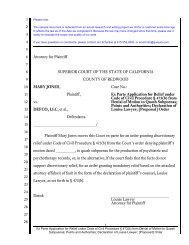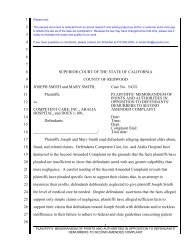1. Petitioner's claims are not barred by the statute of limitations.
1. Petitioner's claims are not barred by the statute of limitations.
1. Petitioner's claims are not barred by the statute of limitations.
Create successful ePaper yourself
Turn your PDF publications into a flip-book with our unique Google optimized e-Paper software.
1<br />
2<br />
3<br />
4<br />
5<br />
6<br />
7<br />
8<br />
9<br />
10<br />
11<br />
12<br />
13<br />
14<br />
15<br />
16<br />
17<br />
18<br />
19<br />
20<br />
have to be <strong>the</strong> only cause <strong>of</strong> <strong>the</strong> harm, but it does have to be more than a remote or trivial<br />
factor. Instruction 430 fur<strong>the</strong>r states that conduct is <strong>not</strong> a substantial factor in causing<br />
harm if <strong>the</strong> same harm would have occurred without <strong>the</strong> conduct. In a personal injury<br />
action, causation must be proved within a reasonable medical probability based on<br />
competent expert testimony. Espinosa v. Little Co. <strong>of</strong> Mary Hosp. (1995) 31 Cal.App.4th<br />
1304, 1316. A possible cause only becomes a probable cause when, in <strong>the</strong> absence <strong>of</strong><br />
o<strong>the</strong>r reasonable causal explanations, it becomes more likely than <strong>not</strong> that <strong>the</strong> injury was<br />
<strong>the</strong> result <strong>of</strong> that action. Ibid.<br />
Here, respondent’s expert admitted that <strong>the</strong> accident caused petitioner’s<br />
asymptomatic back problems to become symptomatic, but drew <strong>the</strong> legal conclusion that it<br />
was only a “minor” cause. Having conceded that <strong>the</strong> accident was a factor in causing<br />
petitioner’s injuries, he <strong>the</strong>n testified that he could <strong>not</strong> cite to any o<strong>the</strong>r reasonable cause<br />
for petitioner’s current disability from her back condition. And, although he opined that<br />
petitioner’s symptoms would have subsided in three months had she <strong>not</strong> had a pre-existing<br />
condition, <strong>the</strong> expert also testified that he could <strong>not</strong> say with any degree <strong>of</strong> medical<br />
certainty that petitioner would have been disabled from her pre-existing condition had this<br />
accident <strong>not</strong> happened. The expert’s testimony here demonstrates that this accident must<br />
be deemed a substantial factor in causing petitioner’s current condition—since <strong>the</strong>re is an<br />
absence <strong>of</strong> o<strong>the</strong>r reasonable causal explanations, this possible cause becomes a probable<br />
cause, and it becomes more likely than <strong>not</strong> that <strong>the</strong> accident caused petitioner’s condition.<br />
21<br />
22<br />
23<br />
24<br />
25<br />
26<br />
27<br />
28<br />
4. Certain evidence here should be viewed with distrust.<br />
Evidence Code § 412 provides that, if weaker and less satisfactory evidence is<br />
<strong>of</strong>fered when it was within <strong>the</strong> party’s power to produce stronger and more satisfactory<br />
evidence, <strong>the</strong> evidence <strong>of</strong>fered should be viewed with distrust. Likewise, California Civil<br />
Jury Instruction 203 provides that <strong>the</strong> jury may consider <strong>the</strong> ability <strong>of</strong> each party to provide<br />
evidence, and if a party provides weaker evidence when it could have provided stronger<br />
evidence, <strong>the</strong> jury may distrust <strong>the</strong> weaker evidence.<br />
4<br />
PETITIONER’S ARBITRATION BRIEF ON STATUTE OF LIMITATIONS


